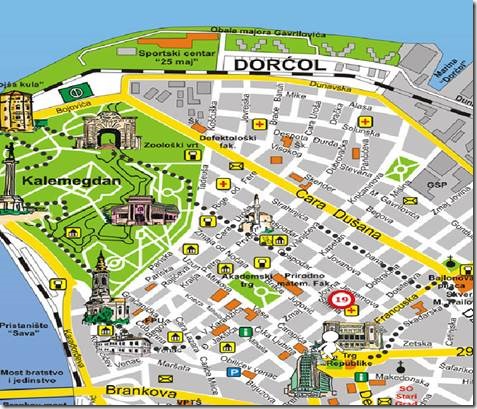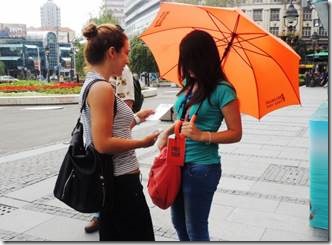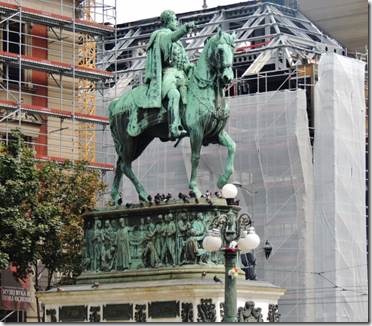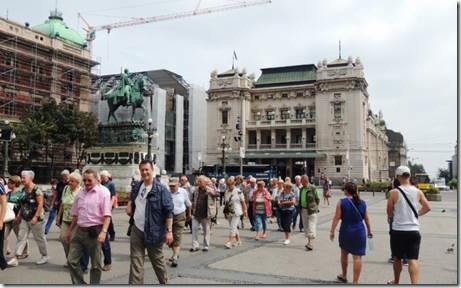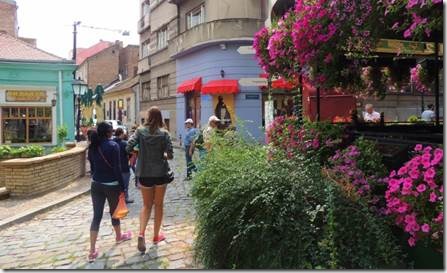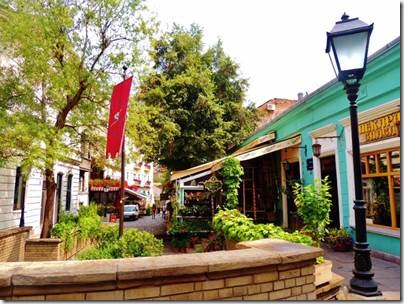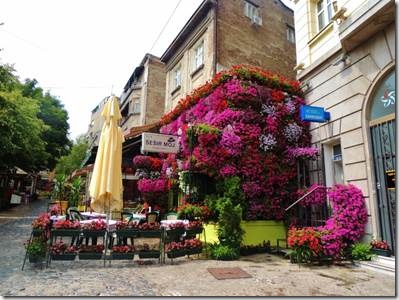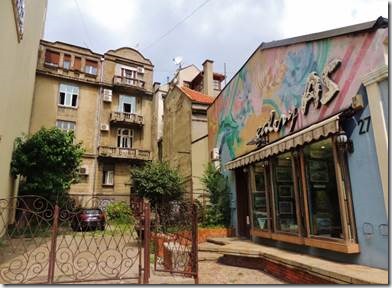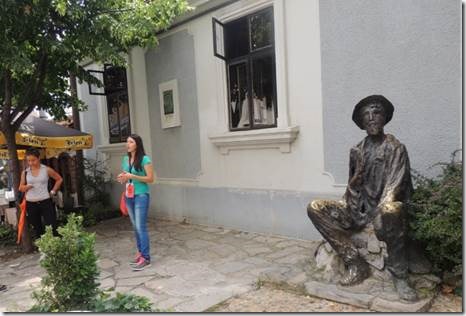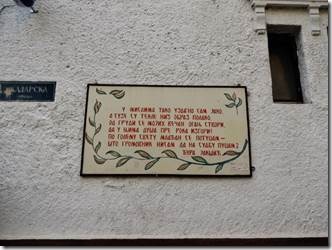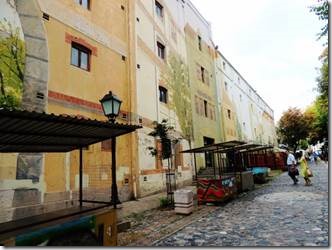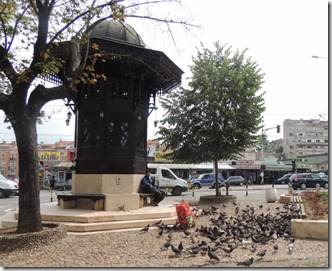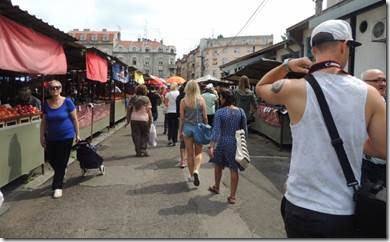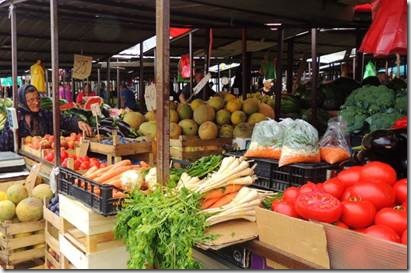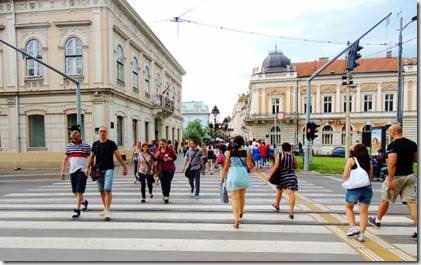Oryahovo, Bulgaria
добър вечер dobŭr vecher = Good Evening in Bulgarian
Oryahovo or Orjahovo is a picturesque ruin which I know nothing about at this point. But I will another day. We went for a stool uphill into town, stopped for a drink and then for a few groceries. It had been a long day of 113 kilometers or about 61 miles. We left Vidin in the rain at 8:40 am and arrived in Oryahovo at 3:55 pm in the sun. By the way, we jumped ahead an hour when we got to Bulgaria though none of us first realized it. We still arrived earlier than most people at the restaurant barge next door. Good thing because an hour later there were no tables.
This email takes us back to Belgrade and you will learn more than you ever wanted to know because Randal and I really liked Belgrade and went on two walking tours of the city as well as long walks with Rick and Mary to visit their friends, a work colleague of Ricks. So lots and lots of photos. I am rushing through this a bit (believe it or not) so hopefully it all makes sense. I’ve left the history of Belgrade text for the end, after the photos.
Ru
Randal and I like to participate in walking tours so as I did in Budapest, I Googled “Free Walking Tours” Belgrade.
“Free Belgrade city center walking tour. Insightful, fun-filled and informative walks with locals who will tell you about the city’s history, society, architecture, cuisine, night-life and much more. Focused around the most relevant sights Belgrade city center has to offer. The goal of this walking tour is to discover and experience our city through the eyes of insiders, to bring to life streets, bridges and statues, and of course, to have fun. The tour ends near the famous Knez Mihailova street with useful tips for easy orientation when searching for museums, places to go out, places to eat out, and especially for avoiding tourist traps in the city.” http://belgradefreetour.com/free-tours/
The walk lasts 2.5 hours and covers;
•Republic square
•Knez Mihailova street
•Bohemian quarter
•Green Market
•Silicon Valley
•Mosque
•Kalemegdan park
•Belgrade Fortress
•Roman well
•Belgrade underground
•Cathedral church… and much more
|
This is the route we followed and it took all of the 2.5 hours plus. Good thing I brought snacks. DoraMac was located not far from the orange Sport Center on the water. So we walked from there to Republic Square and then back to the fortress with the tour and then back toward Republic Square where the tour ended. And then back to Doramac! |
|
Katrina the tour veteran and Dora, with the orange umbrella who was leading her first tour with Katrina to help her out when necessary. |
|
Prince Mihaijlo Obrenovic statue This stumped me right away trying to remember the stories we were told and none of us remembered the same stories relating to the lack of a crown on Prince Mihaijlo’s head. I remember the “story” of the sculptor being so mortified for forgetting the crown that he commit suicide. NOT TRUE. Rick, Randal and Mary remembered some story about a second statue being made in another town by the same sculptor and that one had a crown. I can’t find any proof of that. And then there’s the story about the “horse’s ass “ café or maybe it really is the restaurant behind the horse. “Favorite thing: I have been assured that Republic Square is not the literal center of Belgrade but it is only about 100 yards from Terazije which is the official center of Belgrade. Nevertheless, every time that I have been asked to meet someone in Belgrade it has been either "at the horse statue,"(which is in Republic Square) or at the train/bus station. Many bus lines stop by Republic Square. It is also the site of some of Belgrade’s most recognizable public buildings, including the National Museum and the National Theatre. "The horse statue" is actually a bronze statue of Prince Michael (or Mihailo) on a horse, by the Italian sculptor Enrico Pazzi. It was erected in 1882 in honor of the Prince’s most important political achievement, the complete expulsion of the Turks from Serbia and liberation of the remaining seven cities within what was then (in 1867) Serbian territory. The names of the cities are carved on plates on the monument, on the statue’s pedestal, and the prince is allegedly sculpted with his hand pointing toward Constantinople, indicating where he wanted the Turks to go. However, his hand actually points to the north-east instead of the south-east, which is the correct direction from Belgrade to Turkey. In recent years, the honor accorded to Prince Mihailo has declined significantly and the statue is often referred to simply as kod konja (Serbian for ‘at the horse’). Even the nearby restaurant is named, Kod Konja.” Republic Square by etfromnc Written Aug 15, 2011 http://www.virtualtourist.com There is rather common and morbid legend about the inauguration ceremony – the story says that a child cried "Knez has no cap! He is bareheaded!!!". Pazzi’s "mistake" was the cause of his suicide. Reality is quite more pleasant – on the inauguration ceremony Pazzi received the Medal of the Knight of the Royal Order of Takovo of II degree from King Milan Obrenovic. He lived in Florance for 17 more years, and died in 1899, at the age of 80. http://www.virtualtourist.com/ Our guides told us this story though I’m not sure they said it was a story….. More tangential trivia…. http://www.theflorentine.net/articles/article-view.asp?issuetocId=6520 interesting article showing how Pazzi’s life intertwined with the poet Dante. We were also told the code of a horse’s legs related to statues. Prince Mihaijlo Obrenovic was actually assassinated not hurt or killed in battle. But the code is questionable anyway. This reply to a letter about the horse’s legs code was written by the Superintendent of the National Park Service in the US. “Dear Sir: Your letter of October 19, 1931 is received and noted. The story that the posture of the horse in equestrian statues on this battlefield indicates whether the rider was killed, wounded, or unhurt seems to be one of those myths which grow up around historical places and are almost impossible to destroy. Sculptors whom I have consulted assure me there is no such convention connected with the art. This office does not countenance the story. On the contrary, invariably discourages it. It seems, however, to appeal to some imaginations among both guides and tourists. If you are in position to supply the name of your guide or the number of his cap, I can possibly stop one from further reciting the myth. Very truly yours, E. E. Davis, Superintendent National Park Service “ |
|
National Museum on the left “under-reconstruction and the National Theater on the right. The museum apparently contains a wonderful collection of prehistoric artifacts, icons, religious books, Serbian and European art. The renovation has been going on for years and years with the museum remaining closed. No end in sight apparently which seems a shame but the locals seemed resigned to that. |
|
The small but charming old “Bohemian Quarter” Once the home of many Serbian poets, writers, artists, and actors, the cobble-stoned Skadarlija (or Skadarska) street today hosts some of the best restaurants in Belgrade, all of which strive to preserve bohemian traditions from the early 19th century. Definitely the place to go if you want to get a feel of the atmosphere of Belgrade’s old times, cruise art galleries, shop for antiques or souvenirs, or taste the best of local food.” http://www.belgradeeye.com/skadarlija.html The tale of the origins of Skadarlija tells us that in that very spot, many a year ago, a mother with her daughter and son decided to settle down. This was spurred by the predictions of an old lady, telling of how her children would become famous, her son a sage and her daughter a princess. As long years went by and her children grew up, the prediction of the old woman came true to the letter, so the mother, somewhat melancholy for her children leaving, found herself back on the Skadar slope. She sat and recalled everything and, as if relieved, she felt her first tears rolling down her cheeks. And so it began. Evermore, the tears of weariness, emptiness and joy flowed together, gushed over the meadow and kept flowing downhill into a tiny stream. The stream slowly carved the ground, leaving an ever increasing runnel, like a small river bed. The meandering slope carried the water downhill. A spring of potable water sprung up in this very place. In time, people started settling down on both sides of the stream. At first, these were poor slums, followed by inns visited by the poor, artists and actors. Thus the Skadarska Street was born, later well known as Skadarlija, eventually becoming but a pale shadow of the former bohemian street. However, the spring still flows to this day… Maja Stamenković, Legends of Belgrade, Signature, Belgrade, 2002 http://www.tob.rs/download/Everlasting%20Skadarlija.pdf a 22 page pdf file that tells everything you’d want to know about the area. Skadarlija is the old Bohemian Quarter of Belgrade and dates back to late 19th and early 20th century. It was back then when its kafane (taverns and restaurants) were a meeting place for many of the greatest figures of the cultural scene of the period. It is often compared with the Montmartre in Paris, both for its appearance and the cheerful, vigorous artists’ atmosphere. The area is home to some of Belgrade’s best restaurants, offering the traditional national cuisine, most notably the roštilj (grilled meat) with pivo (beer). Every restaurant has live musicians playing traditional songs. The musicians travel from table to table and the guests often sing along. Serbian cuisine is very rich with heavy creams and cheeses. The stuffed peppers were a particular favorite of ours, which we enjoyed with each of our meals. I recommend a nighttime stroll around Kalemegdan park to walk off a bit of your meal! http://jdombstravels.com/ |
|
Đura Jakšić ‘s house Djura Jaksic (1832-1878) was a poet, painter, narrator, play writer, and great patriot. He occasionally spent time in Novi Sad and was friendly with Jasa Ignjatovic (another famous Serbian author….. A 150 cm. bronze monument, also by Jovan Soldatovic and erected in 1990, stands before Jakšic’s former home in Skadarlija, Belgrade…” http://www.hyperbyte.net/Jaksic/ is a good introduction to the art and poetry of Djura Jaksic Birthland This rocky pile of Serbian earth, which thrusts Up through the cloud, and menaces the sun, By the dark wrinkles of its sullen brow Tells of times infinitely far away And shows us, as in a silent mimicry, The deep-sunk furrows on its face engraven. Ages of darkness-here behold their print In those black wrinkles, in those pits of gloom. This pile of stone is like some pyramid That springs out of the dust towards high heaven, A heap, no more, of craggy skeletons Which, in their mortal combat with the foe, Thy fathers of their own free choice had raised, Cementing with the blood of patriot hearts Their shattered bones and sinews – to prepare For their sons’ sons a place of ambuscade Whence they, with scornful valor, should hereafter Await the foe, with all his ravening bands. Thus far, no farther, to this pile of stone This mighty ramparts, Thy unclean foot may chance to penetrate! Wilt thou dare farther?…Thou shalt hear the thunders Breaking the quiet of this land of freemen With horrible clamor; thou shalt understand Then, in thy coward soul, their dauntless voice; And then, upon that hard and rocky wall Shalt break the bald crown of thy shaven pate In wild distraction and dismay; and yet Through the dread crash and rattle of that warfare Shalt hear one single utterance, one thought: – ‘Behold the Serbians’ birthland, now their own!’ http://www.experienceproject.com Plaque on the wall of Ðura Jakšic’s house in Skadarska (Skadarlija), Belgrade: Tiny print isn’t a problem; it’s all in Serbian so impossible to read. The frustration in being and English/Latin alphabet only person. And Hebrew print; I can recognize the letters of Hebrew print even if I can’t translate most of it anymore. Little further stands brewery BIP that used to belong to one of the richest Belgrade families, Bajloni. At the very end of the street, you will find Sebilj Fountain, replica of the fountain that stands in Baščaršija in Sarajevo. Although Skadarlija is not particularly convenient for high heels and tipsy walk, it is still very appealing among visitors of all ages. http://www.belgradian.com/sightseeing/skadarlija/ |
|
Maybe the Brewery? |
|
Sebilj Fountain Aleksandar Vitek, architect (Skadarska Street; erected in 1989) The Sebilj Fountain at the lower end of Skadarlija is a replica of the Sebilj Fountain in Baščaršija, donated to Belgrade by Sarajevo in 1989. According to Ottoman tradition the Sebilj or public fountains were built on squares or crossroads. http://www.tob.rs/en/see_in.php?id=102 The Sebilj (Bosnian: sebilj – Turkish: sebil) is a kiosk-shaped public fountain made out of wood and stone, usually built at the public squares or intersections of important roads. Such fountains were common in the lands that were ruled by The Ottoman Empire. The particular design of the fountain that will be built in St. Louis is a work of the Bosnian governor under the Ottomans, Hadži-Mehmed-Paša Kukavica, who built Sarajevo’s Sebilj in 1753 in a part of the city called Baščaršija. The Sebilj in Sarajevo was relocated by Czech architect Alexander Vitek in 1891. He rebuilt the Sebilj with the features of a pseudo-Moorish style of architecture copied from the stone Sebilj in Constantinople (todays Istanbul). That particular Sebilj, built by Vitek, is the one currently located in Sarajevo. Over the years many copies of Sarajevo’s Sebilj were built throughout the world. The city of Sarajevo gave a Sebilj as a gift to the city of Beograd, Serbia in 1989, and that Sebilj is still located in Beograd’s neighborhood of Skadarlije. Novi Pazar (Serbia), Birmingham (England) and Sarajevo’s sister city Bursa (Turkey), also have each a Sebilj modeled after the one located in Sarajevo. Our great hope is for St. Louis to become a host for such a cultural, architectural and historic monument, as a sign of friendship and great respect between the Bosnian community and all other communities in St. Louis. |
|
The fruit and vegetable market |
|
Knez Mihailova street across from the entrance to the Fortress complex. The City Library is the building on the left. More about this pedestrian plaza in another email. |
Info about Belgrade and its history——-
http://www.oryxinflightmagazine.com/europe/bridge-to-belgrade.html is an “in flight” article about Belgrade
http://www.youtube.com/watch?v=muK_6nl40_Q is a 5 minute overview of Belgrade history. There’s a huge jump between WW 1 and WW 2 which is pretty much what we covered in our second walking tour.
History
Belgrade is a city with a tumultuous, but also frequently tragic past, primarily due to its unique position at the confluence of the Sava and Danube rivers, on the border between the East and the West.
Roads run through it and around it, used by invading warrior peoples conquering and destroying this city, rebuilding it and adding to it over and over.
Belgrade has been permanently settled since the mid Neolithic period, the time when its area played host to the Vincian culture, more than 4,000 years B.C.E.
The Greeks came later, followed by the Romans who pushed the Celts across the Sava and Danube rivers, installing their fourth legion, the Legio Flavia, at Singidunum. They built a mighty fort on the Kalemegdan ridge with a city next to it.
From the Celtic dun and the Roman castrum the city grew into a significant border fortification of the Huns and then the Byzantine emperors Anastasius and Iustinianus, the Avars, Bulgars, Ugars, Serbs, Turks and Austrians, until it became the capital of modern Serbia during the 19th century.
The name Belgrade was first recorded in a letter on April 16, 878, when Pope John VIII notified the Bulgarian Emperor Mihail Boris that he had removed from office Sergi (“episcopus Belgradensis”) due to sinful living.
Belgrade had around ten names in the past. As each conqueror claimed it, they immediately changed its name, but the new name almost always spoke of its beauty and whiteness. It was called Belgrad, Bello Grado, Alba Urbs, Alba Graeca, Griechisch Weissenburg, Nándor Fehérvár, Nándor Alba, Castelbianco. All these names are translations of the Slavic word Beograd.
This city, living through and surviving numerous wars and destruction during the centuries, is one of the oldest cities in Europe, and thus had a number of symbolic names, such as: House of Winds, Combat Hill, Thinking Hill, House of Freedom…
It became the capital of the Serb medieval state during the reign of King Dragutin Nemanjić who married the princess Katerina and therefore received Belgrade, Mačva and Srem as dowry from the Hungarian king, as well as during the time of Despot Stefan Lazarević who, as the vassal of the Ugric king received Belgrade in his possession, along with a number of other large estates. Only in the 19th century, at the time of the First Serbian Uprising and subsequently, during the reign of Prince Miloš, from 1841 onwards, did Belgrade become the permanent capital of the Principality, and thereafter the Kingdom of Serbia. Following World War I, in 1918, it became the capital of the Kingdom of Serbs, Croats and Slovenes, and thereafter of the Kingdom of Yugoslavia. After World War II it regained its position as the capital of the country of Yugoslavia that changed its name a number of times, only to become, once again and finally, the capital of Serbia.
Belgrade gradually grew from an oriental town into a modern mid-European city during the 19th century. It had 25,178 residents and 3,444 houses at the time the Turks left Belgrade in 1867.
The first electric light was switched on in Belgrade in 1882, while the first train took off towards Niš from the Belgrade railway station on August 23, 1884.
The first cobbled road in Belgrade, made up of oaken cobbles, was laid down in 1886 in Kralja Petra I Street, between Knez Mihailova and the Cathedral Church. As the spring rains started to fall, shoots sprang forth from those cobbles, to the delight of the citizens of Belgrade.
The first horse-drawn tram was engaged on October 1, 1892. Water pipelines were installed in several streets in the city centre during the same year.
The first telephone rang in 1890, while the first cinema projection was held in 1896, a mere six months after the first projection by the Lumière brothers in Paris.
Belgrade had a population of 50,000 citizens and grew into a true European capital during the early 20th century. Unfortunately, it was bombed and demolished during World War I, and the same occurred in World War II, when the Nazi Luftwaffe turned a large part of the city to dust and rubble in 1941. The cycle was repeated in 1944 when the allied Anglo-American air force repeatedly demolished large parts of the city in addition to the few remaining German military facilities. Unfortunately, another round of destruction, hopefully the last, occurred in 1999 when the NATO Alliance air force destroyed several tens of residential buildings, administrative, communal and production facilities, communications, etc. All of these bombings left behind a large number of human victims, dead, buried in the rubble or wounded.
Belgrade has more than 1,700,000 citizens today and is growing into a true metropolis. More than a quarter of the population of Serbia lives there today! The city is growing towards Šumadija, as well as towards Srem and Banat. It is becoming ever more beautiful, orderly and clean, but also increasingly frantic, since life in Belgrade is ever faster as it is in all big cities.
The makeup of the population of Belgrade often changed during the past centuries. People from all over the Balkans and central Europe moved to it, and many departed under their own volition or under duress, but those that remained became Belgraders within a generation and seldom abandoned it without pressing need.
Data from the book “Beograd, u pola četiri Kod dva bela goluba” by Dragoslav Ž. Savić. http://www.tob.rs/en/belgrade.php?kat=2

